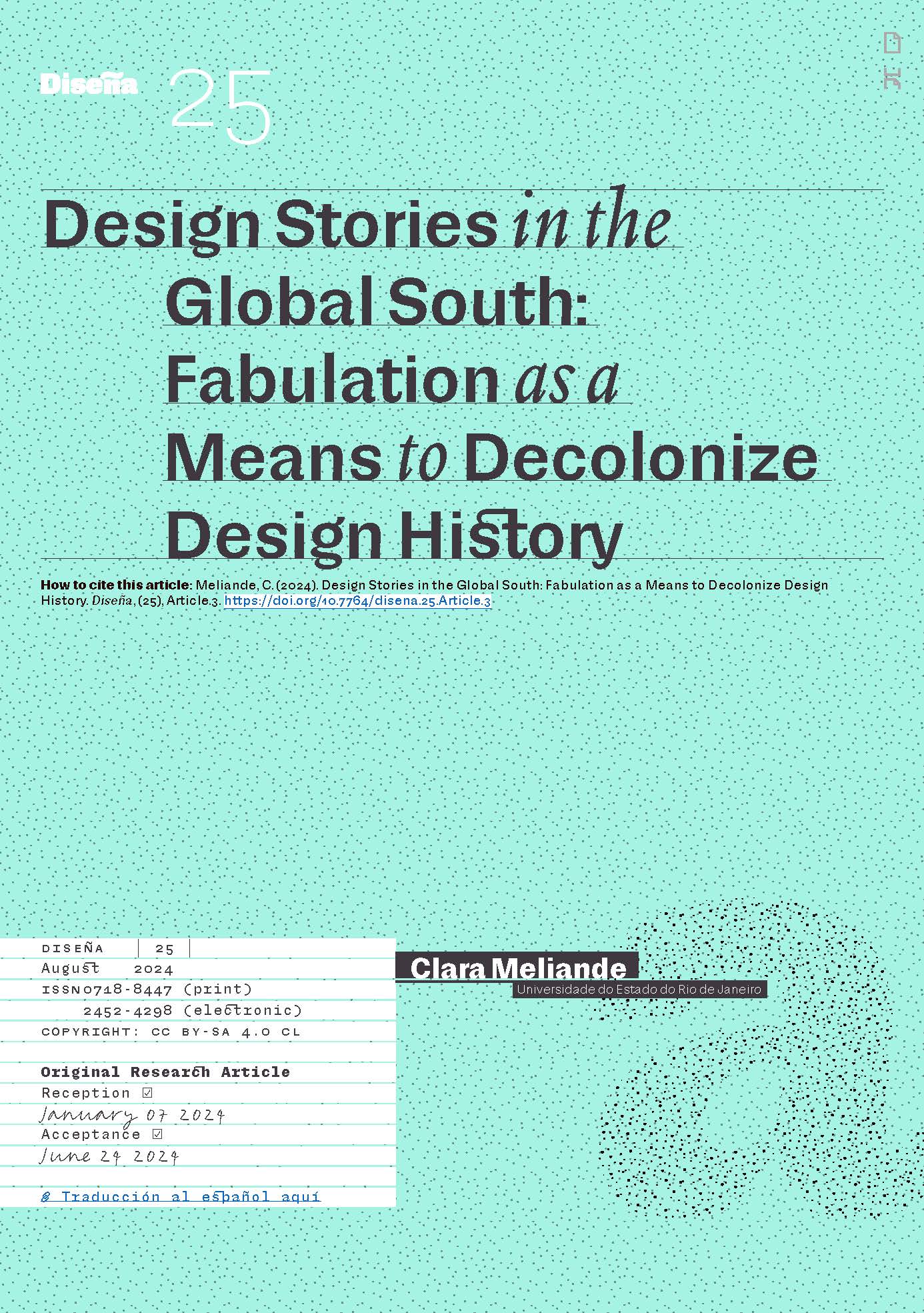Design Stories in the Global South: Fabulation as a Means to Decolonize Design History
Main Article Content
Abstract
This article aims to discuss, through the critical fabulation of Saidiya Hartman, the use of fabulation in the field of design history as a decolonizing methodological tool, as it challenges and problematizes notions of truth and neutrality in research and the boundaries of scientific writing. Assuming that all writing, even that which claims to be committed to reality, has elements of fiction, I argue that researchers in design can engage in writing that, with historical rigor, utilizes imagination not as a means of falsification but as a materialization of what is suggested in documents but escapes the possibility of verification. I conclude that fabulation can be employed as a means to imagine alternative occurrences, as a way to speculate on what cannot be answered through archival materials, and as a tactic for democratizing academic discourse.
Downloads
Article Details

This work is licensed under a Creative Commons Attribution-ShareAlike 4.0 International License.

This work is licensed under a Creative Commons Attribution-ShareAlike 4.0 International license.
COPYRIGHT NOTICE
All contents of this electronic edition are distributed under the Creative Commons license of "Attribution-ShareAlike 4.0 Internacional" (CC-BY-SA). Any total or partial reproduction of the material must mention its origin.
The rights of the published images belong to their authors, who grant to Diseña the license for its use. The management of the permits and the authorization of the publication of the images (or of any material) that contains copyright and its consequent rights of reproduction in this publication is the sole responsibility of the authors of the articles.
References
Agamben, G. (2008). O que resta de Auschwitz: O arquivo e a testemunha [Homo Sacer, III]. Boitempo.
Barcellos, L., & Lambert, C. (2012). Entrevista com Eduardo Viveiros de Castro. Primeiros Estudos, 2, Article 2. https://doi.org/10.11606/issn.2237-2423.v0i2p251-267
Burke, P. (Ed.). (1992). A escrita da história: Novas perspectivas. UNESP.
Chamma, L. N. (2018). A virada antropológica: O retorno do sujeito e da história. Revista Sem Aspas, 7(2), 233–248. https://doi.org/10.29373/sas.v7i2.12493
Colomina, B., Galán, I. G., Kotsioris, E., & Meister, A.-M. (Eds.). (2022). Radical Pedagogies. MIT Press.
Derrida, J. (2001). Mal de arquivo: Uma impressão freudiana. Relume Dumará.
Despret, V. (2022). Autobiografia de um polvo: E outras narrativas de antecipação (M. P. Duchiade, Trans.). Bazar do Tempo.
Escobar, A. (1995). Encountering Development: The Making and Unmaking of the Third World. Princeton University Press.
Favret-Saada, J. (1990). Être affecté. Gradhiva : Revue d’histoire et d’archives de l’anthropologie, 8(1), 3–9. https://doi.org/10.3406/gradh.1990.1340
Foucault, M. (2012). A arqueologia do saber. Forense Universitaria.
Freire, P. (1987). Pedagogia do oprimido (17th ed.). Paz e Terra.
Haraway, D. J. (2016). Staying With the Trouble: Making Kin in the Chthulucene. Duke University Press.
Hartman, S. (2007). Lose Your Mother: A Journey Along the Atlantic Slave Route. Farrar, Straus & Giroux.
Hartman, S. (2008). Venus in Two Acts. Small Axe, 12(2), 1–14. https://doi.org/10.1215/-12-2-1
Hartman, S. (2021). Wayward Lives, Beautiful Experiments: Intimate Histories of Riotous Black Girls, Troublesome Women, and Queer Radicals. Serpent’s Tail.
Hartman, S. (2022, November 29). Mesa-redonda “Ficções e fabulações afro-atlânticas”, com Saidiya Hartman [Video recording]. Museu do Amanhã. https://www.youtube.com/watch?v=E_XjmfTHsmY
Hartman, S., & Siemsen, T. (2018, April 18). On Working with Archives: An Interview with Saidiya Hartman. The Creative Independent. https://thecreativeindependent.com/people/saidiya-hartman-on-working-with-archives/
Hobsbawm, E. J. (2013). Sobre história. Companhia das Letras.
Ingold, T. (2019). Antropologia: Para que serve? Vozes.
Mauad, A. M., & Grinberg, L. (2010). Teoria da história (Vol. 2). Fundação Cecierj.
Mbembe, A. (2002). The Power of the Archive and its Limits. In C. Hamilton, V. Harris, J. Taylor, M. Pickover, G. Reid, & R. Saleh (Eds.), Refiguring the Archive (pp. 19–27). Kluwer. https://doi.org/10.1007/978-94-010-0570-8_2
McLean, S. J. (2017). Fictionalizing Anthropology: Encounters and Fabulations at the Edges of the Human. University of Minnesota Press.
Quijano, A. (2005). Colonialidade do poder, eurocentrismo e América Latina. In E. Lander (Ed.), A colonialidade do saber: Eurocentrismo e ciências sociais. Perspectivas latinoamericanas (pp. 117–142). CLACSO.
Stengers, I., & Despret, V. (2014). Women Who Make a Fuss: The Unfaithful Daughters of Virginia Woolf. Univocal Publishing.
Strathern, M., Crick, M. R., Fardon, R., Hatch, E., Jarvie, I. C., Pinxten, R., Rabinow, P., Tonkin, E., Tyler, S. A., & Marcus, G. E. (1987). Out of Context: The Persuasive Fictions of Anthropology [and Comments and Reply]. Current Anthropology, 28(3), 251–281. https://doi.org/10.1086/203527
Viveiros de Castro, E. (2004). Perspectival Anthropology and the Method of Controlled Equivocation. Tipití: Journal of the Society for the Anthropology of Lowland South America, 2(1). https://digitalcommons.trinity.edu/tipiti/vol2/iss1/1

